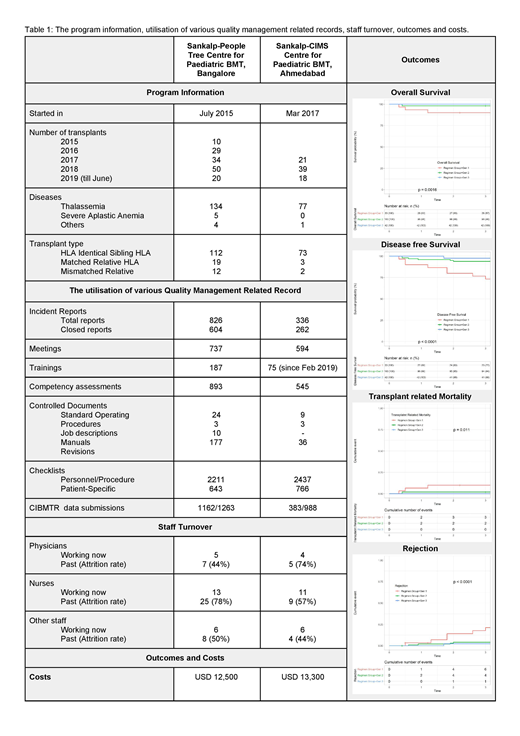Introduction: Continued quality improvement systems are necessary not only to maintain minimum quality standards, but also contribute to improved outcomes (Snowden et al. 2017; Hashmi et al. 2017). In-spite of its importance, the implementation of a functional Quality Management System (QMS) in the routine daily activity oh health professionals may be a challenge, especially in resource limited settings (Hashmi et al. 2017).
Methodology: BMTPlus is an information and communication technology (Agarwal et al. 2014) platform that has been used for knowledge management by Sankalp-People Tree Centre for Paediatric BMT, Bangalore (PTH) from July 2015 and Sankalp-CIMS Centre for Paediatric BMT, Ahmedabad (CIMS) from March 2017. BMTPlus brings together all aspects of transplant data management including clinical data management, personal records and QMS. The usage of these tools which directly relate to the continued quality improvement process was reviewed. Clinical outcomes for patients who underwent transplant for thalassemia in these centres from matched related donors were summarised using R statistical package (version 3.5.x) as an indicator of the effectiveness of the continued quality improvement process.
Results: Table 1 summarises the program information, utilisation of various quality management-related records, staff turnover, outcomes and costs. Information technology-driven QMS provided the unique advantage of being able to audit all the data instead of sample data sets and thus widening the potential to detect issues. The inventory management and prescriptions system was audited in 2019 at PTH and the findings are that there were only 3 events in 4 years where important drugs/supplies came close to a critical shortage. Automated treatment plan imports contributed to 2 of the 1570 drug orders being detected with inaccuracies (0.13%). The PTH BMT service has been using BMTPlus for auto submission of data to CIBMTR; data audit in July 2019 showed that 92% of the 1263 due forms were successfully submitted. CIMS is catching up with 39% forms submitted so far.
The impact of this quality improvement system on clinical outcomes of the program was measured on 172 successive first matched related transplants (103 from PTH and 69 from CIMS) upto April 15 2019. Outcomes were compared across 3 successive transplant protocols, all patients were transplanted at-least 100 days prior to this analysis. Both overall and disease-free survival improved significantly from protocol 1 to 3, i.e. from 88% to 100% (p = 0.002) and from 77% to 98% (p < 0.0001) respectively. Transplant-related mortality and rejection significantly dropped from 10% to 0% (p = 0.01) and from 22% to 3% (p < 0.0001) respectively. The outcomes achieved at this lower-middle income centre compared favourably with the 96.9% day-100 survival reported in USA for thalassemia ("U.S. Patient Survival Report" 2017). Progressively improved outcomes and good utilisation of quality management features were seen in spite of the fact that PTH had an attrition rate as high as 44% for physicians and 78% for nurses while in CIMS this was 74% and 57% respectively.
The impact of quality management on the cost and sustainability of the program can be seen from the cost of the transplants. Though the programs experienced a 10% increase in operational costs on a year on year basis, the ongoing quality improvements led to fewer complications and cost escalations as a result of which the program at PTH and CIMS continue to offer matched-related transplants at USD 12.500 and USD 13.300 respectively which was the bundled cost set at the beginning of the programs in July-2015 and March-2017 respectively.
Thanks to the use of online platform, only one quality/data manager is the only additional resource specific to continued quality improvement, quality assurance, outcome reporting and participation in international registries.
Conclusion: Information and communication technology enabled comprehensive knowledge management and facilitated continuous quality improvement. This contributed to the delivery of cost-efficient and effective transplantations with progressively improving outcomes, which finally are at par with the best centres in the world in spite of the challenges of high staff turnover.
No relevant conflicts of interest to declare.
Author notes
Asterisk with author names denotes non-ASH members.


This feature is available to Subscribers Only
Sign In or Create an Account Close Modal